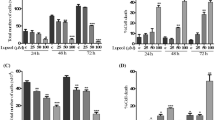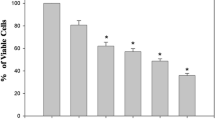Abstract
Cervical cancer is one of the most common gynecological cancers in association with high mortality and morbidity. The present study was aimed to investigate the in vitro effects of zoledronic acid (ZA) on viability and induction of apoptosis and autophagy as well as inflammatory effects in three human cervical cancer cell lines (HeLa, SiHa, and CaSki). Cell viability was measured by 3-(4,5-Dimethylthiazol-2-yl)-2,5-Diphenyltetrazolium Bromide (MTT) assay. Induction of apoptosis was determined by quantitation of expression level of B cell lymphoma 2 (Bcl-2) and Bax messenger RNA (mRNA) and identification of the proteolytic cleavage of poly (ADP)-ribose polymerase (PARP) and caspase-3. Autophagic effects were examined by quantitation of mRNA expression of autophagy protein 5 (ATG5) and beclin1 and identifying accumulation of microtubule-associated protein 1 light chain 3 (LC3)-II. Inflammatory effect was determined by measuring expression and production of IL-6 and cyclooxygenase-2 (Cox-2). The results showed ZA significantly inhibited cell viability of cervical cancer cells. ZA-induced cell death displayed features characteristic to both apoptosis and autophagy and was associated with different changes in the levels of Bcl-2 and Bax in the various cervical cancer lines. Expression of metastatic cytokines, IL-6 and Cox-2, was upregulated in the presence of ZA at low concentration. Our data revealed that ZA inhibits cervical cancer cells through the synergistic effect of apoptosis induction and autophagy activation.




Similar content being viewed by others
References
Munksgaard PS, Blaakaer J. The association between endometriosis and gynecological cancers and breast cancer: a review of epidemiological data. Gynecol Oncol. 2011;123:157–63.
Bresadola F, Terrosu G, Uzzau A, Bresadola V. Distant metastases from cervical esophagus cancer. ORL J for oto-rhino-laryngology and its related specialties. 2001;63:229–32.
Hopkins MP, Morley GW. Prognostic factors in advanced stage squamous cell cancer of the cervix. Cancer. 1993;72:2389–93.
Thanapprapasr D, Nartthanarung A, Likittanasombut P, Na Ayudhya NI, Charakorn C, Udomsubpayakul U, et al. Bone metastasis in cervical cancer patients over a 10-year period. International journal of gynecological cancer : official journal of the International Gynecological Cancer Society. 2010;20:373–8.
Zwolak P, Dudek AZ. Antineoplastic activity of zoledronic acid and denosumab. Anticancer Res. 2013;33:2981–8.
Young RJ, Coleman RE. Zoledronic acid to prevent and treat cancer metastasis: new prospects for an old drug. Future Oncol. 2013;9:633–43.
Lin JF, Lin YC, Lin YH, Tsai TF, Chou KY, Chen HE, et al. Zoledronic acid induces autophagic cell death in human prostate cancer cells. J Urol. 2011;185:1490–6.
Almubarak H, Jones A, Chaisuparat R, Zhang M, Meiller TF, Scheper MA. Zoledronic acid directly suppresses cell proliferation and induces apoptosis in highly tumorigenic prostate and breast cancers. J of carcinogenesis. 2011;10:2.
Morgan G, Lipton A. Antitumor effects and anticancer applications of bisphosphonates. Semin Oncol. 2010;37 Suppl 2:S30–40.
Koto K, Murata H, Kimura S, Horie N, Matsui T, Nishigaki Y, et al. Zoledronic acid inhibits proliferation of human fibrosarcoma cells with induction of apoptosis, and shows combined effects with other anticancer agents. Oncol Rep. 2010;24:233–9.
Ottewell PD, Woodward JK, Lefley DV, Evans CA, Coleman RE, Holen I. Anticancer mechanisms of doxorubicin and zoledronic acid in breast cancer tumor growth in bone. Mol Cancer Ther. 2009;8:2821–32.
Wypij JM, Fan TM, Fredrickson RL, Barger AM, de Lorimier LP, Charney SC. In vivo and in vitro efficacy of zoledronate for treating oral squamous cell carcinoma in cats. Journal of veterinary internal medicine / American College of Veterinary Internal Medicine. 2008;22:158–63.
Kimura S, Kuroda J, Segawa H, Sato K, Nogawa M, Yuasa T, et al. Antiproliferative efficacy of the third-generation bisphosphonate, zoledronic acid, combined with other anticancer drugs in leukemic cell lines. Int J Hematol. 2004;79:37–43.
Caraglia M, Marra M, Naviglio S, Botti G, Addeo R, Abbruzzese A. Zoledronic acid: an unending tale for an antiresorptive agent. Expert Opin Pharmacother. 2010;11:141–54.
Basso FG, Silveira Turrioni AP, Hebling J, de Souza Costa CA. Zoledronic acid inhibits human osteoblast activities. Gerontology. 2013;59:534–41.
Shigemitsu A, Furukawa N, Koike N, Kobayashi H. Endometrial cancer diagnosed by the presence of bone metastasis and treated with zoledronic acid: a case report and review of the literature. Case reports in oncology. 2010;3:471–6.
Labrinidis A, Hay S, Liapis V, Ponomarev V, Findlay DM, Evdokiou A. Zoledronic acid inhibits both the osteolytic and osteoblastic components of osteosarcoma lesions in a mouse model. Clinical cancer research : an official journal of the American Association for Cancer Research. 2009;15:3451–61.
Kassi G, Papamichael K, Papaioannou G, Giagourta I, Thanou S, Triantaphyllopoulou M, Zapanti E, Papandroulaki F, Ktena V, Karga H: Cytokines and insulin resistance after zoledronic acid-induced acute phase response. Immunological investigations 2014
Ferretti G, Fabi A, Carlini P, Papaldo P, Cordiali Fei P, Di Cosimo S, et al. Zoledronic-acid-induced circulating level modifications of angiogenic factors, metalloproteinases and proinflammatory cytokines in metastatic breast cancer patients. Oncology. 2005;69:35–43.
Santini D, Vincenzi B, Dicuonzo G, Avvisati G, Massacesi C, Battistoni F, et al. Zoledronic acid induces significant and long-lasting modifications of circulating angiogenic factors in cancer patients. Clinical cancer research : an official journal of the American Association for Cancer Research. 2003;9:2893–7.
Gupta S, Srivastava M, Ahmad N, Bostwick DG, Mukhtar H. Over-expression of cyclooxygenase-2 in human prostate adenocarcinoma. Prostate. 2000;42:73–8.
Catalano A, Morabito N, Basile G, Brancatelli S, Cucinotta D, Lasco A. Zoledronic acid acutely increases sclerostin serum levels in women with postmenopausal osteoporosis. The Journal of clinical endocrinology and metabolism. 2013;98:1911–5.
Kimachi K, Kajiya H, Nakayama S, Ikebe T, Okabe K. Zoledronic acid inhibits rank expression and migration of osteoclast precursors during osteoclastogenesis. Naunyn Schmiedeberg’s Arch Pharmacol. 2011;383:297–308.
Marra M, Abbruzzese A, Addeo R, Del Prete S, Tassone P, Tonini G, et al. Cutting the limits of aminobisphosphonates: New strategies for the potentiation of their anti-tumour effects. Curr Cancer Drug Targets. 2009;9:791–800.
Yuasa T, Kimura S, Ashihara E, Habuchi T, Maekawa T. Zoledronic acid - a multiplicity of anti-cancer action. Curr Med Chem. 2007;14:2126–35.
Green JR. Bisphosphonates: Preclinical review. Oncologist. 2004;9 Suppl 4:3–13.
Guenther A, Gordon S, Tiemann M, Burger R, Bakker F, Green JR, et al. The bisphosphonate zoledronic acid has antimyeloma activity in vivo by inhibition of protein prenylation. International journal of cancer Journal international du cancer. 2010;126:239–46.
Raikkonen J, Crockett JC, Rogers MJ, Monkkonen H, Auriola S, Monkkonen J. Zoledronic acid induces formation of a pro-apoptotic atp analogue and isopentenyl pyrophosphate in osteoclasts in vivo and in mcf-7 cells in vitro. Br J Pharmacol. 2009;157:427–35.
Aydogan A, Kocer G, Ozmen O, Kocer M, Onal L, Koskan O: Immunohistochemical expression of caspase-3, caspase-5, caspase-7 and apoptotic protease-activating factor-1 (apaf-1) in liver and kidney of rats exposed to zoledronic acid (zol) and basic fibroblast growth factor (bfgf). The Veterinary quarterly 2014:1-18.
Karabulut B, Karaca B, Atmaca H, Kisim A, Uzunoglu S, Sezgin C, et al. Regulation of apoptosis-related molecules by synergistic combination of all-trans retinoic acid and zoledronic acid in hormone-refractory prostate cancer cell lines. Mol Biol Rep. 2011;38:249–59.
Karabulut B, Erten C, Gul MK, Cengiz E, Karaca B, Kucukzeybek Y, et al. Docetaxel/zoledronic acid combination triggers apoptosis synergistically through downregulating antiapoptotic bcl-2 protein level in hormone-refractory prostate cancer cells. Cell Biol Int. 2009;33:239–46.
Tassone P, Tagliaferri P, Viscomi C, Palmieri C, Caraglia M, D’Alessandro A, et al. Zoledronic acid induces antiproliferative and apoptotic effects in human pancreatic cancer cells in vitro. Br J Cancer. 2003;88:1971–8.
Wasko BM, Dudakovic A, Hohl RJ. Bisphosphonates induce autophagy by depleting geranylgeranyl diphosphate. The Journal of pharmacology and experimental therapeutics. 2011;337:540–6.
Chen T, Berenson J, Vescio R, Swift R, Gilchick A, Goodin S, et al. Pharmacokinetics and pharmacodynamics of zoledronic acid in cancer patients with bone metastases. J Clin Pharmacol. 2002;42:1228–36.
Olson K, Van Poznak C. Significance and impact of bisphosphonate-induced acute phase responses. Journal of oncology pharmacy practice : official publication of the International Society of Oncology Pharmacy Practitioner. 2007;13:223–9.
Roodman GD. Biology of osteoclast activation in cancer. Journal of clinical oncology : official journal of the American Society of Clinical Oncology. 2001;19:3562–71.
Srivani R, Nagarajan B. A prognostic insight on in vivo expression of interleukin-6 in uterine cervical cancer. International journal of gynecological cancer : official journal of the International Gynecological Cancer Society. 2003;13:331–9.
Kotowicz B, Fuksiewicz M, Kowalska M, Jonska-Gmyrek J, Bidzinski M, Kaminska J. The value of tumor marker and cytokine analysis for the assessment of regional lymph node status in cervical cancer patients. International journal of gynecological cancer : official journal of the International Gynecological Cancer Society. 2008;18:1279–84.
Lee S, Kim JH, Kim H, Kang JW, Kim SH, Yang Y, et al. Activation of the interleukin-32 pro-inflammatory pathway in response to human papillomavirus infection and over-expression of interleukin-32 controls the expression of the human papillomavirus oncogene. Immunology. 2011;132:410–20.
Morita Y, Hata K, Nakanishi M, Nishisho T, Yura Y, Yoneda T. Cyclooxygenase-2 promotes tumor lymphangiogenesis and lymph node metastasis in oral squamous cell carcinoma. Int J Oncol. 2012;41:885–92.
Author information
Authors and Affiliations
Corresponding author
Rights and permissions
About this article
Cite this article
Wang, IT., Chou, SC. & Lin, YC. Zoledronic acid induces apoptosis and autophagy in cervical cancer cells. Tumor Biol. 35, 11913–11920 (2014). https://doi.org/10.1007/s13277-014-2460-5
Received:
Accepted:
Published:
Issue Date:
DOI: https://doi.org/10.1007/s13277-014-2460-5




